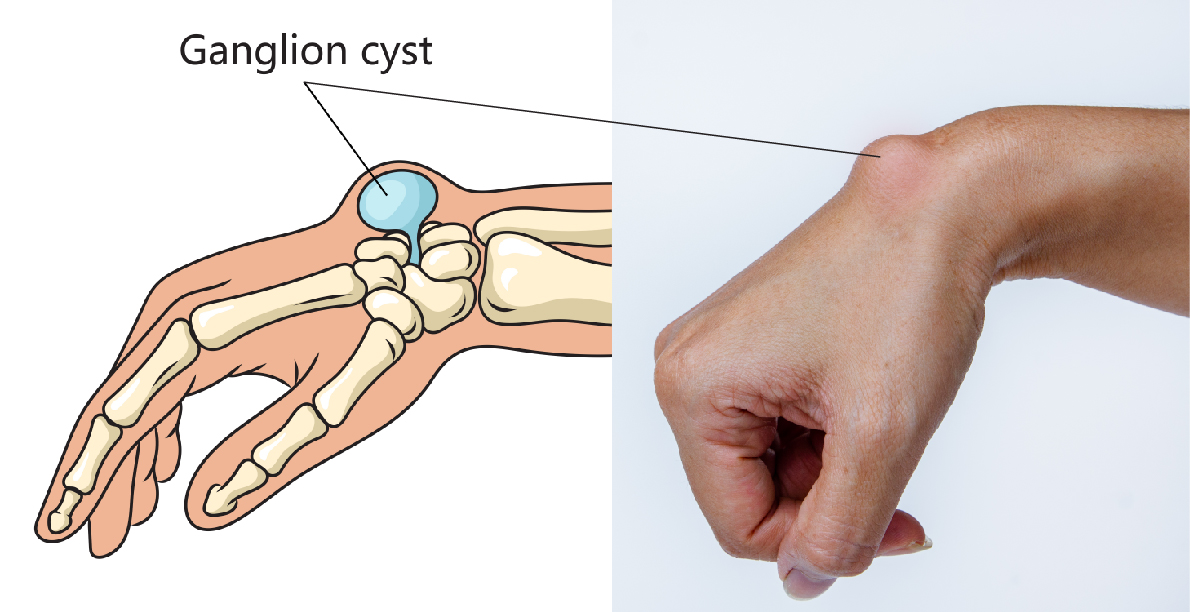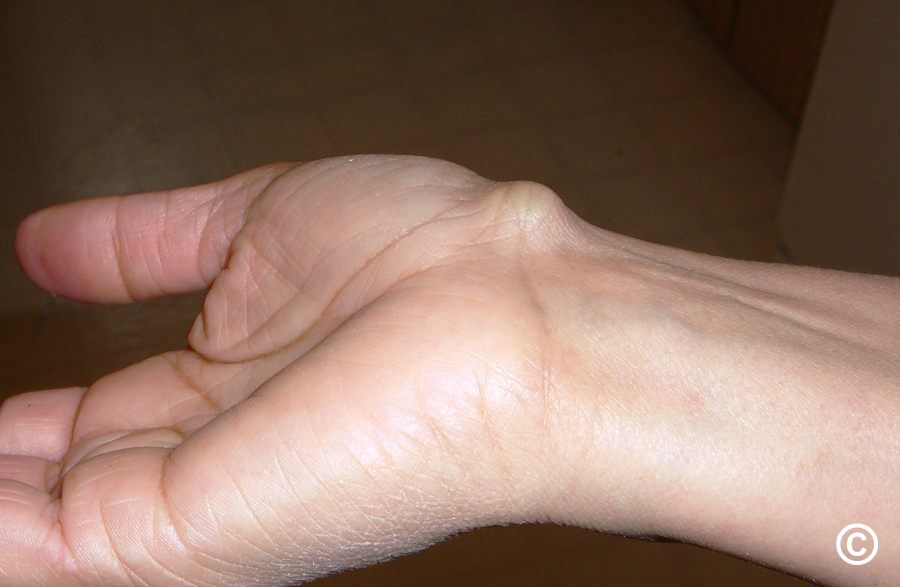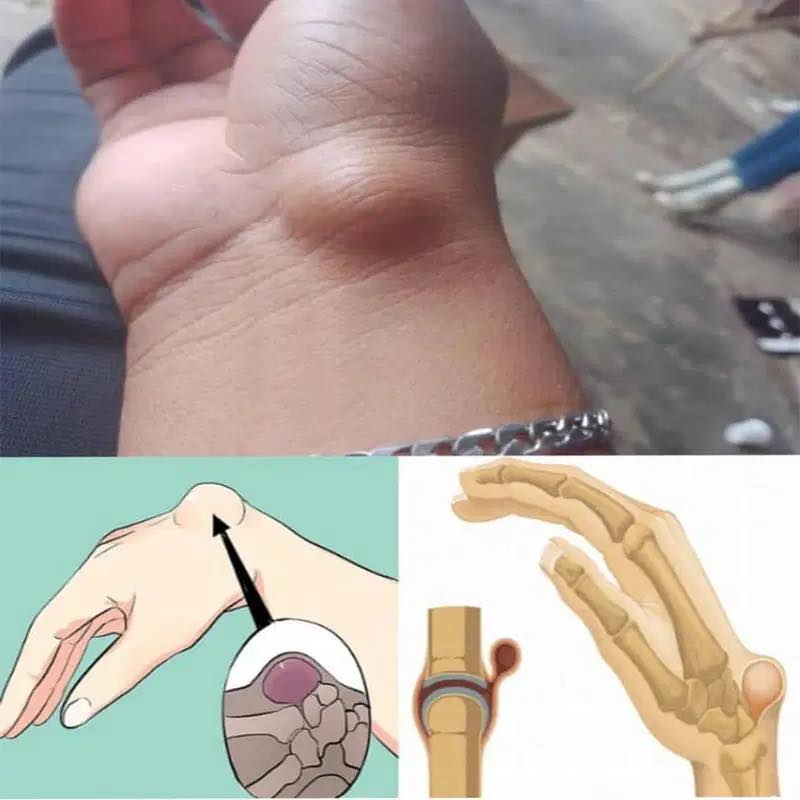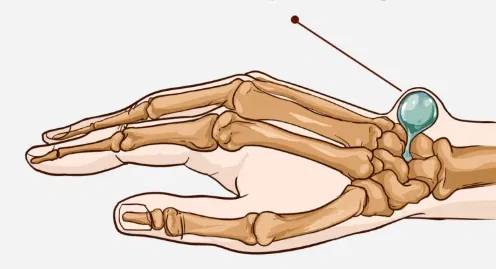A wrist ganglion cyst—also known as a synovial cyst—is a noncancerous, fluid-filled lump that commonly appears on the back or front of the wrist. These cysts can vary in size and may be soft or firm to the touch. While usually harmless, ganglion cysts can sometimes cause discomfort, restrict movement, or affect daily activities, particularly when they press on nearby nerves.
Understanding the causes, symptoms, and evidence-based treatment options can help you manage this condition effectively and decide when to seek medical attention.
What Is a Wrist Ganglion Cyst?
A ganglion cyst is a benign (noncancerous) lump that develops near joints or tendons. These cysts are most often located at the wrist but can also appear on the fingers, hands, or feet. The cyst is filled with thick synovial fluid, which is the same substance that lubricates joints and tendons.
These cysts often fluctuate in size, and their appearance may become more noticeable with increased wrist activity.
Sources:
- Mayo Clinic – Ganglion Cyst
- Cleveland Clinic – Ganglion Cyst Overview

What Causes a Ganglion Cyst?
Although the exact cause of ganglion cysts is not fully understood, several risk factors and activities are associated with their development:
1. Repetitive Wrist Movements
Daily tasks that involve frequent hand or wrist motion, such as typing, using a mouse, writing, or playing musical instruments, may increase stress on the wrist joint. Over time, this repetitive motion may lead to fluid buildup and cyst formation.
2. Joint or Tendon Irritation
Inflammation of the wrist’s soft tissues can cause synovial fluid to collect abnormally, forming a cyst.
3. Previous Wrist Injuries
A past wrist sprain, fracture, or trauma may alter joint function and contribute to cyst formation.

4. Arthritis
People with osteoarthritis, especially in the finger joints, are more likely to develop ganglion cysts. Joint degeneration may lead to fluid leakage that collects into cystic sacs.
5. Age and Gender
Ganglion cysts commonly occur in individuals aged 15 to 40 and are more prevalent in women.
6. Genetics
There may be a hereditary component, as ganglion cysts sometimes run in families.
Source: Johns Hopkins Medicine – Ganglion Cysts
Symptoms of a Ganglion Cyst on the Wrist
While ganglion cysts are generally harmless, they can present symptoms depending on their size and location. Common symptoms include:
- A visible lump on the wrist or hand (usually round or oval)
- A soft or firm texture, depending on fluid pressure
- Pain or aching, especially with wrist movement or pressure
- A feeling of tightness or fullness
- Numbness or tingling if the cyst presses on a nearby nerve
- In rare cases, reduced range of motion
The cyst’s size can fluctuate, sometimes growing with activity and shrinking with rest.

How Are Ganglion Cysts Diagnosed?
Diagnosis is usually made during a physical examination. A healthcare provider may perform the following:
- Visual inspection and palpation of the lump
- Transillumination, where a light is shone through the cyst to see if it’s filled with fluid
- Ultrasound or MRI to rule out other conditions or confirm the cyst’s size and depth
- X-ray, if there’s concern about underlying bone or joint involvement
These tools help distinguish ganglion cysts from other lumps, such as lipomas, infections, or tumors.

Treatment Options for Wrist Ganglion Cysts
The best treatment approach depends on the severity of symptoms, impact on function, and personal preference. Here are the most recommended medical treatments:
1. Observation (“Watch and Wait”)
If the cyst is small, painless, and does not interfere with wrist movement, your doctor may suggest a non-interventional approach. Many ganglion cysts disappear on their own over time without medical treatment.
2. Immobilization
Wearing a wrist brace or splint can reduce joint movement, helping decrease fluid buildup and alleviate pain. Immobilization is typically recommended for mild to moderate symptoms.
3. Aspiration (Needle Drainage)
In this procedure, a physician uses a sterile needle to drain fluid from the cyst. While aspiration can provide temporary relief, recurrence is common because the cyst wall remains intact. The procedure is usually quick and minimally invasive.

4. Surgical Removal (Excision)
For ganglion cysts that are painful, recurring, or limit mobility, surgical excision may be advised. This procedure removes both the cyst and the stalk connecting it to the joint or tendon sheath, reducing the chance of recurrence.
Surgery is typically done under local or regional anesthesia and may involve a short recovery period. Physical therapy may be recommended afterward to restore range of motion.
Sources:
- American Academy of Orthopaedic Surgeons – Ganglion Cyst of the Wrist
- Cleveland Clinic – Ganglion Cyst Treatment
When Should You See a Doctor?
Although ganglion cysts are benign, you should consult a healthcare provider if:
- The lump changes size, color, or consistency
- You experience persistent or worsening pain
- You feel numbness, tingling, or weakness in your hand or fingers
- Wrist movement becomes restricted
- The cyst interferes with daily activities
Prompt medical evaluation ensures accurate diagnosis and appropriate care.

Can Wrist Ganglion Cysts Be Prevented?
There is no guaranteed way to prevent ganglion cysts, but you can lower your risk by:
- Limiting repetitive wrist activities
- Taking frequent breaks during typing or hand-intensive tasks
- Using ergonomic equipment
- Strengthening the muscles around the wrist and maintaining flexibility
If you work in an occupation that requires repetitive wrist movements, consult with an occupational therapist or healthcare provider about preventive exercises or support devices.
Final Thoughts
A wrist ganglion cyst is a common and usually harmless condition that can appear due to repetitive movements or previous wrist injuries. While many cysts resolve on their own, some may cause pain, nerve pressure, or reduced mobility, making medical treatment necessary.
The good news is that ganglion cysts are noncancerous and treatable, with several options ranging from observation to surgery. If you’re concerned about a new lump on your wrist or experience discomfort during movement, it’s best to speak with a medical professional for proper diagnosis and personalized care.
Verified Medical Sources:
- Mayo Clinic – Ganglion Cyst
- Cleveland Clinic – Ganglion Cyst Overview
- Johns Hopkins Medicine – Ganglion Cyst
- American Academy of Orthopaedic Surgeons
